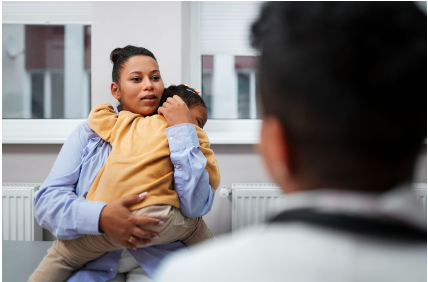This is a guest post. All thoughts and opinions are that of the author. If you have any concerns regarding seizures, please seek medical advice. For more guest posting opportunities, click here.
I placed another load of clothes into the washer and sighed. The holidays were fun, but the amount of dirty clothes that piled up wasn’t. Suddenly, my mother screamed. I ran to her, and she shouted, “M just had a seizure.” “He was just standing there, then he fell and started shaking.”
My two-year-old nephew was on the ground, and she was over him picking him up. His eyes were closed, and he was breathing rapidly. He had been sick the week before with high fevers, but in the last few days, he was back to his normal self running around and having fun. My sister came running to the front room and asked what happened. My mother explained, and my sister immediately started crying.
My mother suggested calling an ambulance, but it was the holidays, and driving to the hospital was faster. I picked up my nephew, my sister got her car keys, and my father hustled behind us. My sister jumped in the driver’s side of the car with her hands and body shaking. I told her to let my father drive, but she didn’t seem to hear me. I grabbed the keys, pushed her to the back of the car, and my father started the drive to the hospital.
While in the backseat of the car, my sister made calls to the hospital’s emergency room, letting them know we were on the way. I cradled my nephew, talking to him, asking him to keep his eyes open. My father while driving kept asking if my nephew was breathing. My father was also panicking and kept blowing at drivers he thought were driving too slow.
We arrived at the emergency room, and my nephew was immediately taken to be seen by the doctor. The tension ebbed, and the adrenaline from the situation decreased, but those minutes were scary.

What is a Seizure?
Duviver and Pollack (2009) define a seizure as “the clinical manifestation of excessive, abnormal cortical neuron activity.” So what does that mean exactly? During a seizure many neurons (nerve cells) fire at once and this can lead to changes in behavior, movement, or feelings.
Types of Seizures
Generalized seizures affecting both sides of the brain
Generalized tonic-clonic seizures
-The child will lose consciousness, muscles will stiffen, and their arms and legs will jerk uncontrollably. These seizures usually last a few minutes, but if they continue for five or more minutes, it is a medical emergency.
Absence seizures
-The child may suddenly stop what they are doing and stare into space. This may be accompanied by chewing motions, fluttering eyelids, and finger rubbing.
Atonic Seizures
-The child will suddenly lose muscle tone and fall to the ground. There may be a brief loss of consciousness with the head dropping down.
Tonic Seizures
-The child’s body will stiffen. This can happen either awake or asleep. The child may suddenly fall to the ground if standing or sitting.
Myoclonic Seizures
-The child will experience sudden muscle contractions affecting one or move limbs. More than one may occur in a short period.
Focal Seizures that affect a single are in one side of the brain
Focal aware seizures
-The child remains alert and awake. They recall having a seizure, but they are unable to interact with others while the seizure is happening.
Focal impaired awareness seizures
-The child is not aware of their surroundings and may not remember the seizure
Focal to bilateral generalized tonic-clonic seizures
The most common seizure in children is a febrile seizure. Febrile means having or showing symptoms of a fever. The International League Against Epilepsy (ILAE) defines a febrile seizure as “a seizure occurring in childhood after one month of age, associated with a febrile illness not caused by an infection of the central nervous system, without previous neonatal seizures or a previous unprovoked seizure, and not meeting criteria for other acute symptomatic seizures.”
Jones and Jacobsen (2007) report that the majority of febrile seizures occur between 6 – 36 months of age. They further report that 3 to 4% of children in North America experience a febrile seizure before the age of five. Initial (first) febrile seizures have been associated with:
- First or second-degree relative with a history of febrile or afebrile seizures
- Daycare attendance
- Developmental delay
- Influenza A viral infection
- Human herpesvirus-6 infection
- Metapneumovirus
- Iron deficiency anemia
Jones and Jacobsen (2007) further reported that parents often suffer from indigestion and lack of sleep when their child experiences a febrile seizure. There is also increased anxiety, fear, and worry about low-grade fevers. I can say that all of these feelings are true. My sister stayed up for the remainder of the evening and night monitoring my nephew. M stayed home from nursery the next few days, and she watched him intensely. He was also discouraged from overexerting himself during play with his friends.

What to Do When a Seizure Occurs?
- Stay calm
- Do not try to hold or restrain the child
- Do not force anything into your child’s mouth
- Move the child ONLY if the situation is dangerous
- Remove surrounding objects that may injure the child.
I think the hardest thing for most parents when they witness their child having a seizure is to stay calm. As I recall the events from that day, I realize the following helped us to get to the hospital quickly and manage a frightening medical situation.
- Car keys were immediately accessible. We always put car keys in the same place every day.
- Emergency numbers were in a central space in bold. We put emergency numbers on the kitchen fridge.
- Medical knowledge. My mother is a retired nurse and knows how to manage a seizure. I would recommend parents enroll in a pediatric CPR and first aid course.
One thing that we didn’t have that could have helped us was a family emergency plan. An emergency plan lists steps to take in a medical emergency and includes who to contact and where to meet when an emergency occurs.
Seizures are scary, but most seizures in children do not lead to life-long trauma. The emergency room doctor referred my nephew to a pediatric neurologist, and my nephew is currently in good health. Let me know if you have ever experienced a medical emergency with your child.
References
Duvivier, E. H., & Pollack Jr, C. V. (2009). Seizures. Rosen’s Emergency Medicine: Concepts and Clinical Practice. 7th ed. Philadelphia, Pa: Mosby Elsevier.
Jones, T., & Jacobsen, S. J. (2007). Childhood febrile seizures: overview and implications. International journal of medical sciences, 4(2), 110.
Author Bio
Hi, I’m Sasha Gardiner. I am a speech-language pathologist, blogger and entrepreneur. I have a passion for working with children and I enjoy blogging about postpartum experiences and parenting toddlers and young children. You’ll also find spiritual elements in my blog posts. In my free time I enjoy reading a good book.
You can connect with me at sashagardiner.com and find me on Pinterest at Devotions From the Nursery.

This is very useful information for everyone to know, even if we don’t have children or know someone who experiences seizures. We can all help if we come across this happening and it’s great to be well-informed. Great post!
LikeLike
Seizures are incredibly scary for anyone, especially when you see someone have a fit x
Lucy | http://www.lucymary.co.uk
LikeLike
This was a fascinating read and so important! I had no idea how many different kinds of seizures there could be I can imagine that would be so scary especially if you’re not sure what to do. This is very helpful will save this!
LikeLike
must’ve ben very scary to witness something like this, thank you for all the great information here x
LikeLike